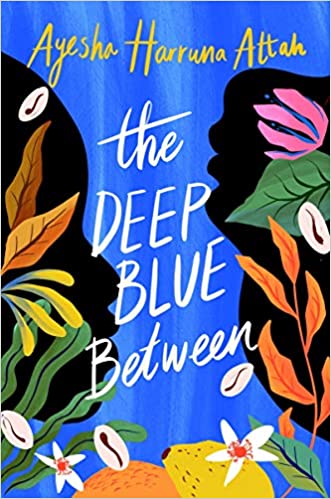
Price: £7.99
Publisher: Pushkin Children's Books
Genre:
Age Range: 14+ Secondary/Adult
Length: 256pp
Buy the Book
The Deep Blue Between
It’s 1892. 10-year-old Hassana and Husseina are twins, living in Botu, West Africa. Their shoemaker father goes to sell his wares in a nearby town; he doesn’t return. Raiders crisp their village to the ground. No idea what happened to mother or grandmother. Brother is stolen, maybe, by a passing human caravan, leaving the twins and their older sister in the grasp of a vicious slave trader. This is certainly a book to add deeper roots to a YA reader’s understanding of BLM.
The story tracks the twins’ separate fortunes over six or seven years in alternating chapters; Hassana tells her own story, while Husseina’s is reported in a more distanced third person narrative, offering interestingly different perspectives for the reader. The two are soon separated. Hassana remains in the West African Gold Coast where she spends time in a Protestant mission and then lodges for a while with a Muslim couple until the soldier husband goes off to fight for the British in the Asanti Wars and returns with life-shattering PTSD. Husseina’s story leads her ever deeper into the Afro-Brazilian religion, Candomble. Her new faith and the welcome she receives from its adherents take her over the ocean to Bahia, an earlier destination for many enslaved West Africans.
A single thread still connects the twins, expressed in short italicised sections punctuating both narratives; their dreams. For Hassana, those dreams are often of blue skies and seas – images so alien to her own experience, that she is convinced she is being visited by her sister’s dreams. Neither girl loses the impulse to search for the other; the need for wholeness remains, despite the passing years.
That’s the intriguing structure. I found it difficult to ignore a persistent query; given that each twin’s growth is shaped by powerful cultural experiences in unfamiliar territories, how much explanation might a young reader need? To take just a couple of illustrations; food and religion. Since there are numerous shifts in geographical settings and communities, food features regularly in the plot: within the first twenty pages, we come across tuo, fufu, kola nuts, nkotomire stew, cocoyam leaf sauce, tilapia. I had no idea what I was reading about in terms of sight or taste. Then again, the contrasting and influential religions the girls encounter. Christianity (both Catholic and Protestant), Islam and Candomblé, including a convincingly detailed account of an initiation ceremony where humans and spirits fuse. The array of gods and spirits includes Otienu (the deity of the twins’ own people), Xango, Oxum, Ibeji and Yemanjá, the orixá who ‘receives’ Hussaina at critical moments in the narrative. Not to mention the babalorixá or the terreiro itself…
Maybe this author’s life experiences resolved this matter for her long ago: born in Ghana, living now in Senegal, educated at three prestigious American universities and author of three successful novels. As she acknowledges, she was also able to draw on the advice of Pushkin’s highly respected Editor-at-large, Sarah Odedina, a recent winner of the Branford Boase Award, as BfK readers may well know. The authorial/editorial decision, challengingly enough, seems to be: very little overt explanation…let the context do the work.
After a first reading, which was not without its confusions, my first response was a lengthy and rewarding spell on Google, finding far more explanations than I expected; which much enriched a second reading. The novel could absorb a reader – adolescent or adult – who relishes immersion in little known cultural contexts; and who is happy to work mostly through inference, rather than explanations which might well have the feel of intrusive footnotes.




